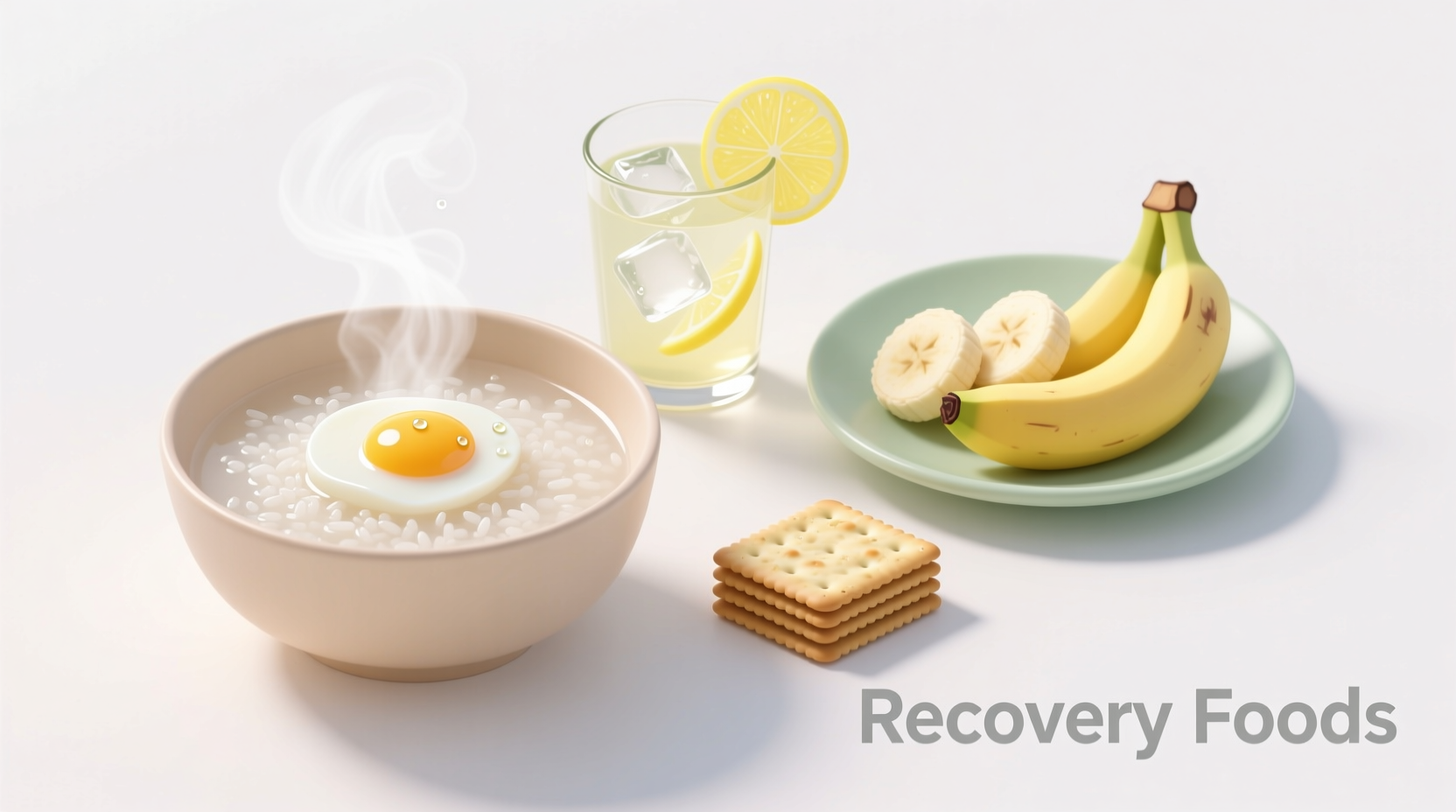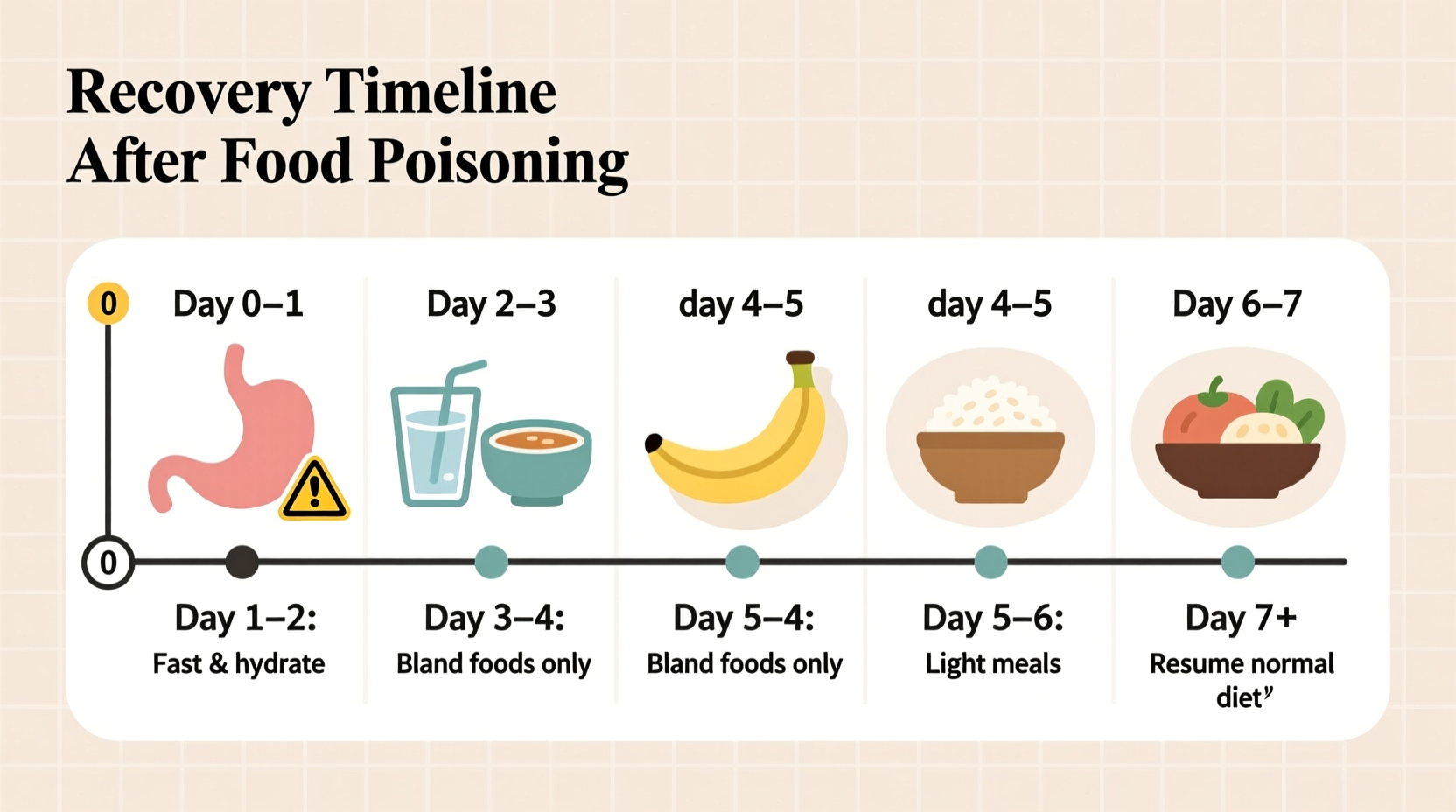Recovering from food poisoning requires careful dietary management to avoid prolonging symptoms. Jumping back into your regular diet too soon can trigger a relapse, while overly restrictive eating may delay healing. Understanding the exact timeline for reintroducing normal foods after food poisoning ensures your digestive system recovers completely without complications.
Understanding Your Food Poisoning Recovery Timeline
The recovery process follows distinct phases, each requiring specific dietary approaches. Your ability to eat normal food after food poisoning depends on several factors including the pathogen type, your overall health, and symptom severity.
| Recovery Stage | Timeline After Symptoms Begin | Dietary Recommendations | Expected Symptoms |
|---|---|---|---|
| Acute Phase | 0-24 hours | Clear liquids only (water, broth, electrolyte solutions) | Severe vomiting, diarrhea, abdominal cramps |
| Rehydration Phase | 24-48 hours | BRAT diet (bananas, rice, applesauce, toast) + electrolytes | Reduced vomiting, occasional diarrhea |
| Transition Phase | 48-72 hours | Soft, bland foods (boiled potatoes, oatmeal, crackers) | Mild digestive discomfort, fatigue |
| Normalization Phase | 3-7 days | Gradual reintroduction of regular foods | Occasional gas or bloating |
| Full Recovery | 7-14 days | Return to normal diet | No digestive symptoms |
Stage-by-Stage Recovery Guide: When Can You Eat Normal Food After Food Poisoning
Phase 1: The Acute Phase (First 24 Hours)
During the initial 24 hours of food poisoning symptoms, your digestive system is in crisis mode. The how long after food poisoning can I eat normal food question doesn't apply yet—your focus should be on hydration, not food. The Centers for Disease Control and Prevention (CDC) recommends consuming small sips of clear liquids every 15 minutes to prevent dehydration without triggering further vomiting. Avoid solid foods completely during this phase, as your stomach cannot process them effectively.
Phase 2: Rehydration and Initial Recovery (24-48 Hours)
As vomiting subsides, you can begin introducing the BRAT diet (bananas, rice, applesauce, toast). These bland, low-fiber foods are gentle on your recovering digestive system. According to Mayo Clinic guidelines, this phase typically begins 24 hours after your last episode of vomiting. The BRAT diet provides necessary carbohydrates without irritating your sensitive stomach lining. Continue electrolyte replacement during this period, as diarrhea can deplete essential minerals.

Phase 3: Transition to Solid Foods (48-72 Hours)
By the second or third day after food poisoning, you can expand your diet to include other bland, easily digestible foods. This critical transition period after food poisoning requires careful food selection. Add boiled potatoes, plain oatmeal, saltine crackers, and boiled chicken to your menu. The NHS advises against high-fat, spicy, or sugary foods during this phase, as they can trigger digestive distress. Most people mistakenly believe they can return to normal eating at this stage, but your gut lining remains vulnerable.
Phase 4: Gradual Normalization (3-7 Days)
During days 3-7 after food poisoning, you can slowly reintroduce your regular diet. Start with one "normal" food at each meal and monitor your body's response. The optimal timeline for returning to normal diet after food poisoning varies based on individual factors. If you experience gas, bloating, or discomfort after eating a particular food, eliminate it and try again in 24-48 hours. The American Gastroenterological Association notes that dairy products often require extra time to reintroduce, as temporary lactose intolerance commonly follows foodborne illness.
Phase 5: Full Recovery (7-14 Days)
Complete recovery from food poisoning typically takes 7-14 days, even after symptoms have subsided. Your gut microbiome needs time to rebalance after the pathogen invasion. Research published in the Journal of Food Protection indicates that premature return to normal eating patterns can extend recovery time by 2-3 days on average. Most healthy adults can resume their regular diet within a week, but children, elderly individuals, and those with compromised immune systems may require up to two weeks for full digestive recovery.
Special Considerations for Different Food Poisoning Types
The how long to wait after specific food poisoning types varies significantly depending on the causative agent:
- Norovirus: Typically resolves in 1-3 days; normal diet can resume 48-72 hours after symptoms stop
- Salmonella: Symptoms last 4-7 days; full recovery takes 5-10 days before normal diet
- E. coli: Recovery takes 5-10 days; avoid high-fiber foods for at least 7 days
- Listeria: Requires medical supervision; normal diet may take 2-3 weeks to resume
- Campylobacter: Symptoms last 2-10 days; gradual reintroduction over 7-14 days
Warning Signs That Require Medical Attention
While most food poisoning cases resolve with home care, certain symptoms indicate you should seek medical help before attempting to eat normal food after food poisoning:
- Signs of severe dehydration (dark urine, dizziness, no urine for 8+ hours)
- Blood in vomit or stool
- Sustained high fever (above 101.5°F/38.6°C)
- Symptoms lasting longer than 3 days without improvement
- Inability to keep liquids down for 24 hours
Practical Tips for Safe Dietary Reintroduction
Follow these evidence-based strategies to ensure your recovery after food poisoning is smooth and complete:
- Start small: Begin with 1-2 tablespoons of food and gradually increase portions
- Introduce one new food at a time: Wait 4-6 hours between new food introductions
- Avoid common triggers: Dairy, caffeine, alcohol, spicy foods, and high-fat foods for at least 5 days
- Monitor symptoms: Keep a food diary to identify problematic foods
- Stay hydrated: Drink 8-10 ounces of fluid with each meal during recovery
According to the FDA Food Code, improper handling of food during recovery can lead to reinfection or secondary infections. Always wash hands thoroughly before preparing food, and avoid sharing utensils with others until fully recovered.
When You Can Safely Resume Your Regular Diet
The definitive answer to how long after food poisoning can I eat normal food is: when you've had 48 consecutive hours without vomiting or diarrhea AND can tolerate bland foods without discomfort. For most people, this occurs between 3-5 days after symptoms begin. However, complete digestive recovery takes longer—typically 7-10 days—before your system functions at pre-illness capacity.
Listen to your body's signals rather than adhering strictly to a calendar. If you experience cramping, bloating, or loose stools after introducing a particular food, eliminate it and try again in 24-48 hours. Rushing the recovery process by eating normal food too soon after food poisoning can prolong symptoms by several days.
Preventing Future Episodes: Food Safety Practices
Once you've fully recovered and returned to normal eating, implement these CDC-recommended food safety practices to prevent recurrence:
- Wash hands thoroughly before handling food
- Cook meats to proper internal temperatures
- Refrigerate perishables within 2 hours (1 hour if above 90°F)
- Separate raw meats from ready-to-eat foods
- Wash fruits and vegetables thoroughly
Understanding the precise timeline for eating normal food after food poisoning helps you navigate recovery safely and efficiently. By following this medically-reviewed guidance, you'll minimize discomfort while supporting your body's natural healing process.











 浙公网安备
33010002000092号
浙公网安备
33010002000092号 浙B2-20120091-4
浙B2-20120091-4